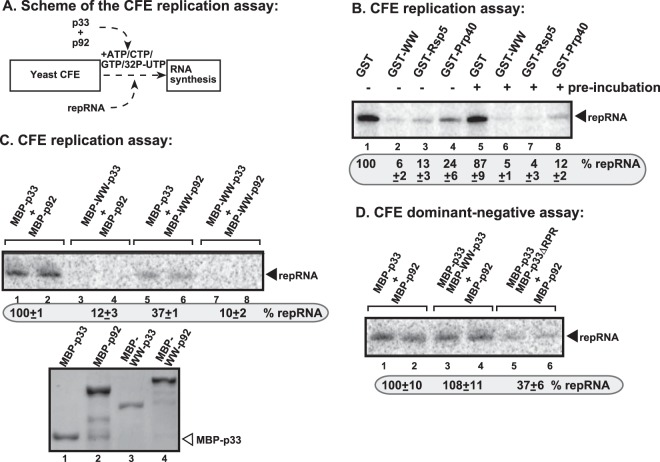FIG 3.
WW domain does not show dominant-negative effect on TBSV replication in a yeast cell extract. (A) Scheme of the CFE-based TBSV replication assay with purified recombinant proteins and added TBSV DI-72 (+)repRNA. All of the recombinant proteins were added simultaneously to the CFE. (B) Denaturing PAGE analysis shows the level of repRNA accumulation in the CFE-based replication assay. The yeast cell extract (CFE) containing host factors and cellular membranes required for TBSV replication were programmed with in vitro-synthesized DI-72 (+)repRNA and purified MBP-p33, MBP-p92, and the shown GST-tagged yeast proteins, all of which were expressed in E. coli. The reactions included [32P]UTP to detect newly synthesized DI-72 repRNA. Note that the CFE is capable of supporting full cycle of TBSV replication, leading to asymmetrical (+)RNA and (−)RNA synthesis on the added (+)repRNA. For the samples in lanes 5 to 8, the GST-tagged yeast proteins were preincubated with MBP-p33 for 10 min prior to the CFE-based replication assay. (C) For the top panel, denaturing PAGE analysis shows the level of repRNA accumulation in the CFE-based replication assay. The CFE assays were performed as in panel B, except that purified MBP-p33 and MBP-p92 or the shown fusion proteins, all of which were expressed in E. coli, were used. For the bottom panel, SDS-PAGE, followed by Coomassie blue staining of the purified recombinant proteins used in panel C, was performed. (D) The lack of dominant-negative effect of WW domain in the fusion protein on the activities of p33 and p92 replication proteins in a CFE-based replication assay. See further details in panels B and C.

